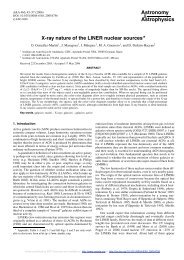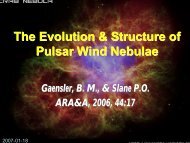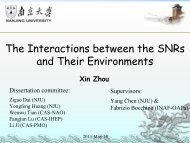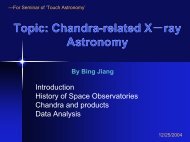Create successful ePaper yourself
Turn your PDF publications into a flip-book with our unique Google optimized e-Paper software.
第五章 星际介质和恒星形成<br />
§5.1 星际气体<br />
§5.2 星际尘埃<br />
§5.3 恒星形成的理论模型<br />
§5.4 恒星形成的观测证据<br />
Chapter 18<br />
Chapter 19
Our Galaxy in Stars, Gas, and Dust
§5.1 星际气体 (Interstellar Gas)<br />
1. 星际介质 (interstellar medium)<br />
星系内分布在恒星与恒星之间(~6-10 ly)的物质。<br />
包括星际气体、星际尘埃、宇宙线与星际磁场。<br />
星际物质的质量约为银河系恒星质量的10%。<br />
主要分布在距离银道面约1000 ly的范围内。
性质<br />
质量百分比<br />
组成<br />
粒子数密度<br />
质量密度<br />
温度<br />
研究手段<br />
气体<br />
99%<br />
HI, HII, H2 (70%);<br />
He (28%);<br />
N, Ne, Na等(2%)<br />
10-24 gcm-3 ~1 (10-3-103 ) atom cm-3 (vacuum: 104 molecules<br />
cm-3 )<br />
~ 100 K, 10 4 K, 20 K<br />
( HI, HII, H2)<br />
星际吸收线、HI 21厘米<br />
谱线、分子谱线<br />
尘埃<br />
1%<br />
固体粒子(直径~ 0.01-<br />
0.1mm),如冰、硅、<br />
石墨等<br />
~10 -13 cm -3<br />
10 -27 gcm -3<br />
10-20 K<br />
星际消光和红化、星际<br />
极化、红外热辐射
2. 星际气体 (interstellar gas)<br />
星际气体主要由H构成;<br />
星际气体的空间分布是不均匀的(星云、冕气),密<br />
度分布~10 -2 -10 6 cm -3 ;<br />
在不同环境下H的存在方式不一样(HI 区、HII 区、<br />
分子云)。
Basic Types of Gaseous Regions<br />
Cold, dense molecular gas (T = 20 K, n > 1000 cm-3 ): these<br />
clouds contain most of the mass of the ISM, but occupy a very<br />
small relative volume because they're so cold and dense.<br />
Cold gas (T = 100 K, n = 20 cm-3 ): these clouds of primarily<br />
neutral atomic gas occupy about 3 times the volume of the colder<br />
clouds above.<br />
Hot neutral gas (T = 6000 K, n = 0.3 cm-3 ): this gas surrounds the<br />
colder clouds and occupies about one fifth of the total ISM<br />
volume.<br />
Hot ionized gas (T = 8000 K, n > 0.5 cm-3 ): this gas surrounds<br />
hot stars and consists mainly of ionized hydrogen (i.e. protons).<br />
Very hot medium (T = 106 K, n = 0.001 cm-3 ): this medium,<br />
heated by shock waves from supernovae, occupies most of the<br />
volume of the ISM.
3. 电离H云的观测—发射星云 (emission nebulae)<br />
被高温(O, B0-2型)恒星的紫外辐射电离的星际物<br />
质,也称为HII区。<br />
M8 (Lagoon Nebula)
(1) 特征<br />
具有(容许和禁戒)发射线,颜色偏红<br />
典型温度~8000 K(←谱线宽度)<br />
NGC2346 及其光谱
(2) 辐射原理<br />
容许谱线 (permitted lines)<br />
星云原子中的电子受高温恒星紫外<br />
辐射而激发或电离。<br />
电子的复合或退激发产生偏红的<br />
H α (~ 6563Å ) 发射.<br />
禁戒谱线 (forbidden lines)<br />
发射星云中的低温、低密度条件<br />
→禁戒跃迁<br />
→ 绿色O[III]辐射<br />
Orion Nebula
The Rosette Nebula: True Color and Emission<br />
Line Images<br />
Hydrogen<br />
Oxygen<br />
NGC 2244
4. 中性H云的观测——星际吸收线 (interstellar<br />
absorption lines)<br />
在某些热恒星(特别是双星中)<br />
光谱中出现并非来自恒星大气<br />
的吸收线,如H的Lyman线和Ca,<br />
Na, Fe等吸收线。<br />
特征:尖锐、无周期性Doppler<br />
位移。
原因:星际气体中的原<br />
子受恒星紫外光子的电<br />
离而产生吸收线。<br />
星际气体低温→窄吸收<br />
线<br />
恒星的星光在到达地球<br />
前可能会穿过多块气体<br />
云,由于每块云的运动<br />
状态不同,可能会出现<br />
多重吸收线。<br />
星际吸收线的位置反映<br />
了星云的运动。
5.中性H云的观测—— H原子21厘米谱线<br />
1944 年H. van de Hulst 预言中性H 原子(T~100-3000 K)<br />
可以产生波长21厘米的射电谱线。<br />
H原子中的电子在自旋与原子自旋平行状态和反平行状<br />
态间的跃迁产生的射电谱线,频率1.42 GHz,波长21厘<br />
米。<br />
尽管单个H 原子的跃迁概率极低,由于星际空间中的H<br />
非常丰富,其产生的21厘米谱线仍然能够观测到。
由于不受到尘埃的散射影响,H原子21厘米谱线是研究<br />
银河系大尺度结构的重要手段。<br />
谱线位移→视向速度→距离→分布
Gas Distribution in the Galaxy
6. 星际分子的观测<br />
当星际介质的温度很低(~3 - 20K)时,星际分子开始<br />
形成。<br />
星际分子分布在大的、冷的、致密的暗云中。<br />
已观测到包括H2 , CO, OH, NH3 等约100种无机和有机分<br />
子,其中H2 分子含量最丰富(有机分子H2CO [甲醛]-<br />
NH2CH2COOH [氨基乙酸])。<br />
CO emission in the Galaxy
分子辐射<br />
(a) 电子跃迁紫外和可见光波<br />
段)<br />
(b) 分子振动跃迁 红外波段<br />
(c) 分子转动跃迁 射电波段
示踪分子<br />
H 2 分子不发射射电辐射,但通常与CO、HCN、NH 3 、<br />
H 2 O 分子成协。<br />
如利用CO 分子的2.6毫米射电辐射可以研究H 2 分子的<br />
分布。<br />
光学 射电
分子云 (molecular clouds)<br />
通过观测CO 分子的辐射,发现星际分子聚集成团形成<br />
分子云。<br />
质量:1-10 6 M ⊙ ,直径:1-600 ly,密度:10 3 -10 5 cm -3<br />
分子云占据银盘内大约1%的空间,质量大约占星际气<br />
体总质量的50%。
0.5 ly<br />
The Dark Molecular Cloud Barnard 68
A cloud with a diameter of<br />
~300 light years.<br />
Giant Molecular Clouds<br />
Temperatures ~ 20 K, number<br />
densities~ 100-300 cm -3 ,<br />
masses ~ 10 6 M ⊙ .<br />
Only about 10% of the cloud<br />
will be in clumps dense enough<br />
for stars to form.<br />
Giant molecular clouds last for<br />
10 to 100 million years before<br />
they dissipate.
7. 云际气体 (intercloud gas)<br />
在星际云间的空间中也存在气体。主要有中性的稀薄气<br />
体和更稀薄的热气体(~104 K)。<br />
紫外和X射线观测还发现存在一类温度高达106-107 K的<br />
热气体,称为云际冕气 (coronal gas) 。<br />
20 - 60%的星际空间被云际冕气占据 。<br />
这些气体的高温主要来自超新星的加热。
成分<br />
HI 区<br />
分子云<br />
HII 区<br />
云际气体<br />
云际冕气<br />
小结:星际气体的主要性质<br />
观测证据<br />
21厘米谱线,<br />
紫外吸收线<br />
红外辐射,紫外吸<br />
收线,CO射电和红<br />
外辐射<br />
光学和红外发射<br />
线,射电连续辐射<br />
21厘米谱线<br />
X射线 (OVI)辐射<br />
温度 (K)<br />
50-100<br />
10-50<br />
10 4<br />
7,000-10 4<br />
10 6<br />
密度 (cm -3 )<br />
1-50<br />
10 2 -10 9<br />
10-10 4<br />
0.2-0.3<br />
10 -4 -10 -3<br />
质量百分比<br />
40%<br />
40%<br />
极少<br />
20%<br />
0.1%
§5.2 星际尘埃 (Interstellar Dust)<br />
1. 星际消光 (interstellar extinction) 与<br />
红化 (interstellar reddening)<br />
1930 年R. J. Trumpler 在研究疏散<br />
星团的距离和大小时,得到了一<br />
个奇怪的结果:疏散星团离太阳<br />
越远,直径就必须越大,才能符<br />
合疏散星团的视亮度和直径的统<br />
计关系。<br />
这种关系成为星际尘埃存在的证<br />
据。
星际消光 (interstellar extinction)<br />
星际尘埃对星光的吸收和<br />
散射造成星光强度的减弱。<br />
考虑星际消光的影响后,<br />
实际测量的天体的视星等<br />
应为:<br />
m = M − 5 + 5logd + A V<br />
在银道面附近星际消光<br />
量为 A v /d = 2 m kpc -1
Interstellar Extinction and Reddening<br />
星际红化 (interstellar<br />
reddening)<br />
星际尘埃对星光的散射<br />
随波长的变化而不同,<br />
对蓝光散射较多而对红<br />
光散射较少,因而造成<br />
星光颜色偏红。
2. 星际尘埃的性质<br />
成分与形状<br />
硅或石墨微粒,<br />
外面被冰或二氧化碳包裹。<br />
星光极化→长条形
形成<br />
形成于红(超)巨星的外层大气(低温→气体凝结)<br />
在恒星演化晚期被吹向星际空间。<br />
星际尘埃与星际分子<br />
分子云中的尘埃屏蔽了星光中的紫外线,使分子免遭<br />
瓦解,<br />
尘埃有利于分子形成。<br />
Fractal Interstellar Dust
3. 星际尘埃云的光学观测——反射星云和暗星云<br />
反射星云 (reflection nebulae)<br />
星云通过尘埃反射附近的热星的星光而发光,颜色偏蓝。<br />
热星的光谱型一般晚于B3型。<br />
昴星团
暗星云 (dark nebulae)<br />
大量的尘埃阻挡了星云内<br />
部或后面恒星的星光。<br />
马头星云<br />
鹰云
星云<br />
亮星云:发射星云,反射星云<br />
暗星云<br />
三叶星云 (Trifid nebula)
4. 尘埃的红外热辐射<br />
尘埃可以有效地吸收光学和紫外辐射。<br />
尘埃粒子受附近热星辐射的加热,温度可以达到~100 K,<br />
产生红外热辐射。<br />
蛇夫星云(Rho Ophiuch)
Inside the Elephant's Trunk
Spitzer Sheds Infrared Light on Hundreds<br />
of Newborn Stars<br />
RCW49
§5.3 恒星形成的理论模型<br />
1. 银河系内的恒星形成过程<br />
银河系(可见)质量 ~1011M⊙ ,年龄 ~1010 yr<br />
→ 银河系平均恒星诞生率 ~10 M⊙yr-1 O型星寿命~106 yr<br />
→ O型星是最近形成的天体<br />
→目前的恒星诞生率 ~3 M⊙yr-1
2. 恒星形成理论模型<br />
恒星形成于银河系旋臂上的致密分子云核。<br />
云核的坍缩造成恒星成群形成。<br />
星云坍缩、分裂、加热 → 原恒星 → 主序星
金斯(Jeans)不稳定性<br />
当星云的质量足够高时,(向内的)重力超过由热运动<br />
和湍动产生的(向外的)压力,引起星云的收缩。星云<br />
不稳定的极限质量称为金斯(Jeans)质量。<br />
动能 3<br />
K = NkT 势能<br />
2<br />
当2K < |U|,星云坍缩<br />
M<br />
3<br />
T<br />
n(<br />
cm<br />
J = 30 −3<br />
)<br />
M ⊙<br />
GM<br />
R<br />
中性氢云:n ~1 cm -3 , T ~100 K → M J ~3×10 4 M ⊙<br />
暗分子云:n ~10 6 cm -3 , T ~10 K → M J ~1 M ⊙<br />
→ 恒星形成于巨分子云中 → 恒星成群形成<br />
U<br />
3<br />
~ −<br />
5<br />
2
Effects against Gravity<br />
Galactic tidal forces (on<br />
galactic scales).<br />
Rotation, turbulence and<br />
magnetic fields (on the<br />
intermediate scale of<br />
GMCs).<br />
Thermal pressure (on the<br />
small scales of individual<br />
prestellar cloud cores).
阶段<br />
1<br />
2<br />
低质量(类太阳)恒星的形成过程<br />
(1) 致密云核 (dense cloud core)<br />
云核坍缩,并分裂成小云块(密度上<br />
升,金斯质量减小)。<br />
(2) 星云团块 (cloud fragments)<br />
星云仍十分稀薄,热量可以不受阻碍<br />
地散逸,星云内的温度没有明显上<br />
升。<br />
观测天体<br />
星际云<br />
云块<br />
核心温<br />
度(K)<br />
10<br />
100<br />
表面温<br />
度(K)<br />
10<br />
10<br />
核心密度<br />
(cm -3 )<br />
10 3<br />
10 6<br />
直径<br />
(cm)<br />
10 19<br />
10 17<br />
持续时间<br />
(yr)<br />
2×10 6<br />
3×10 4
阶<br />
段<br />
3<br />
(3) 团块/原恒星 (fragments/protostars)<br />
星云进一步坍缩和分裂,密度上升。<br />
核心区域变得不透明,温度迅速上<br />
升,金斯质量增大。<br />
星云停止分裂,云块(原恒星)开<br />
始坍缩。<br />
观测天体<br />
云块/原恒星<br />
核心温<br />
度(K)<br />
10 4<br />
表面温<br />
度(K)<br />
100<br />
核心密度<br />
(cm -3 )<br />
10 12<br />
直径<br />
(cm)<br />
10 15<br />
持续时<br />
间 (yr)<br />
10 5
(4) 原恒星 (protostars)<br />
原恒星以Kelvin-Helmhotz时标收<br />
缩,温度进一步升高,快速吸<br />
积物质。<br />
阶段<br />
4<br />
观测天体<br />
原恒星<br />
核心温<br />
度(K)<br />
10 6<br />
表面温<br />
度(K)<br />
3000<br />
核心密度<br />
(cm -3 )<br />
10 18<br />
直径<br />
(cm)<br />
10 13<br />
持续时<br />
间 (yr)<br />
10 6
(5) 主序前星 (pre-main-sequence<br />
stars)<br />
原恒星向主序演化成为主序前<br />
星(金牛座T型星),但内部温<br />
度还没有升高到H的点火温度。<br />
阶段<br />
5<br />
观测天体<br />
主序前星<br />
核心温<br />
度(K)<br />
5×10 6<br />
表面温<br />
度(K)<br />
4000<br />
核心密度<br />
(cm -3 )<br />
10 22<br />
直径<br />
(cm)<br />
10 12<br />
持续时<br />
间 (yr)<br />
10 7
(6) 零龄主序星 (zero-age mainsequence<br />
stars)<br />
恒星到达主序,热核反应(H燃烧)<br />
开始进行,成为零龄主序恒星。<br />
光度约为现在太阳光度的2/3。<br />
(7) 主序星 (main-sequence stars)<br />
恒星略微收缩,达到流体静力学<br />
平衡。<br />
阶<br />
段<br />
6<br />
7<br />
观测天体<br />
零龄主序<br />
主序星<br />
核心温<br />
度(K)<br />
10 7<br />
1.5×10 7<br />
表面温<br />
度(K)<br />
4500<br />
6000<br />
核心密<br />
度(cm -3 )<br />
10 25<br />
10 26<br />
直径<br />
(cm)<br />
2×10 11<br />
1.5×10 11<br />
持续时<br />
间 (yr)<br />
3×10 7<br />
10 10
具有不同质量恒星的形成<br />
不同质量的恒星在形成过<br />
程中,在H-R图上沿不同<br />
的路径演化。<br />
质量越高的恒星,其原恒<br />
星演化到主序的时间越<br />
短,在主序上的位置越高。<br />
原恒星质量 (M ⊙ )<br />
原恒星演化时间 (yr)<br />
0.2<br />
10 9<br />
1.0<br />
3×10 7<br />
5.0<br />
7×10 6<br />
15.0<br />
6×10 4
Angular Momentum Problem<br />
The amount of angular momentum (AM) in a<br />
typical star forming cloud core is several orders of<br />
magnitude too large to be contained in a single star.<br />
Two possible ways to dispose the excess AM<br />
AM is transported to outlying diffuse material in<br />
an accretion disk.<br />
AM goes into orbital motions of the stars in a<br />
binary or multiple system.
Formation of Binary and Multiple Systems<br />
Theoretical and numerical work<br />
has suggested that formation of<br />
binary and multiple systems is<br />
the usual result of collapse with<br />
rotation, while the formation of<br />
single stars occurs only in special<br />
cases.
Simulation: Formation of Stars and Brown<br />
Dwarfs<br />
QuickTime?and a<br />
Cinepak decompressor<br />
are needed to see this picture.
褐矮星 (brown dwarfs) – Failed Stars<br />
Masses < 0.08 M ⊙ (10M J - 84 M J )<br />
Central temperature < 3 million K<br />
Surface temperature ~ 1000 K
Brown Dwarfs - Failed Stars<br />
TWA 5 and its brown dwarf companion in<br />
Infrared (left) and in X-ray (right).
Differences between brown dwarfs and planets<br />
Planets are smaller and lighter<br />
Planets have a solid core<br />
They are formed in a complete different way
Formation of Massive Stars and Clusters<br />
Massive stars have masses that are much larger than the<br />
Jeans mass in the cloud cores where they form.<br />
The large cloud cores might contain many small bound<br />
clumps.<br />
These cores might form groups or clusters of stars.<br />
NGC 3603
Intense radiation emitted by a massive accreting protostar<br />
can produce feedback effects on the infalling envelope that<br />
limits continuing accretion.<br />
It is still not known whether accretion or protostellar<br />
interactions (e.g. mergers) can play an important role in<br />
formation of massive stars.
Initial Mass Function<br />
Generally more low-mass than high-mass stars form when an<br />
interstellar cloud fragments.<br />
The stellar initial mass function (IMF) describes the<br />
probability of a star forming with a particular mass.<br />
φ(<br />
m) ∝ m<br />
m<br />
H<br />
with φ(<br />
mdm ) = 1<br />
∫<br />
m<br />
L<br />
− x<br />
For Salpeter IMF, x =− 1.35
3. 转动星云的坍缩与行星系统的形成<br />
转动星云在坍缩过程<br />
中会形成围绕原恒星<br />
旋转的环或盘。
Protoplanetary disk of gas and dust.<br />
→ The dust grains accumulate into planetesimals(星子).<br />
→ The planetesimals keep growing, eventually becoming planets.
Millions of planetesimals remain outside of Neptune’s orbit<br />
as pristine icy bodies.<br />
They are the source of short period (
Discovering Extrasolar Planets<br />
More than 300 planets are known outside our solar system.<br />
It is striking that most of these systems have massive planets<br />
in orbits comparable to or smaller than the orbit of Mercury.
Occurrence of Planets Correlates with Stellar<br />
Metallicity
4. 星云坍缩的触发机制<br />
(1) 激波压缩<br />
超新星爆发、热星辐射或银河系<br />
旋臂转动等过程产生激波。<br />
激波压缩附近的星云,使其密度<br />
增大,触发恒星的形成。<br />
恒星形成过程可能类似于链式反<br />
应。<br />
如星云M20中的激波压缩效应
(2) 星云碰撞→辐射→冷却→坍缩
Multiple Infrared Views of Spiral Galaxy<br />
Messier 81<br />
24 μm<br />
8.0 μm<br />
visible-light<br />
3.6 μm
§5.4 恒星形成的观测证据
1. 恒星形成区和原恒星的观测<br />
猎户星云 (M42),位于猎户之剑附近,距离约<br />
1000 ly。
光学:左下方棒形物是受<br />
到中心“梯形恒星”<br />
(trapezium stars) 辐射电离<br />
而发光的气体。<br />
红外:在右上方有一个<br />
明亮的星云,其中的橙<br />
色区域是被恒星星风驱<br />
散的氢分子。
(左)光学(放大):“梯形恒星”清晰可见。(右)<br />
红外(放大):可以看到成团的新生恒星,被光学星<br />
云后面的尘埃云包裹。
“梯形恒星”的放大<br />
照片。它们照亮了周<br />
围的气体。<br />
猎户星云中的原恒星及其周<br />
围的尘埃盘。
Visualization of the Orion Nebula<br />
QuickTime?and a<br />
YUV420 codec decompressor<br />
are needed to see this picture.
The First Infrared Images of the Dust Disc<br />
around Fomalhaut
Gas Pillars in M16 - Eagle Nebula
原恒星外流与HH天体<br />
原恒星在吸积过程中有强烈的星<br />
风和喷流。<br />
喷流与周围星际介质相互作用的<br />
产生Herbig-Haro天体。
Gas Outflows from Young Stars<br />
XZ Tauri HH 30
2. 疏散星团的H-R图<br />
星团NGC 2261的H-R图:<br />
原恒星到达主序的位置和<br />
时间随质量的变化。
















